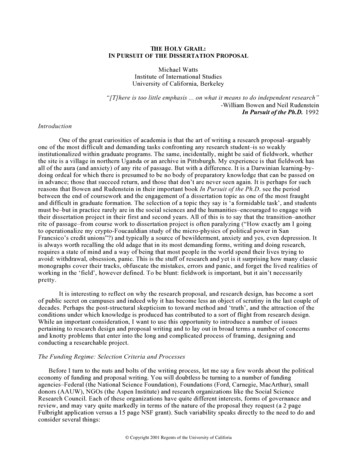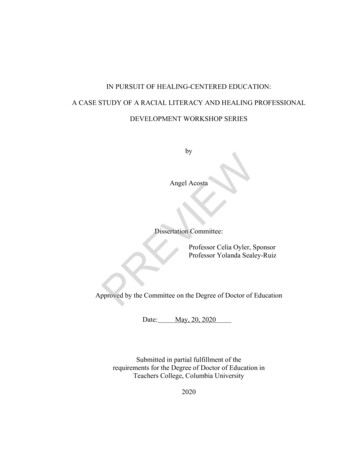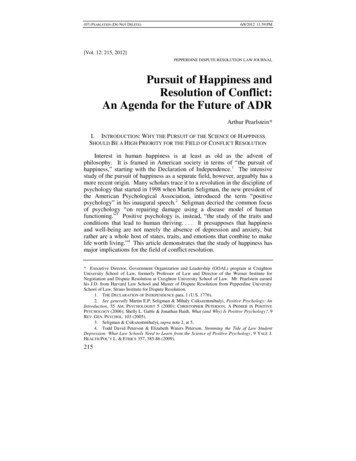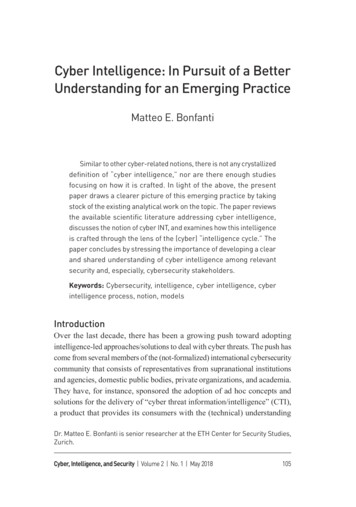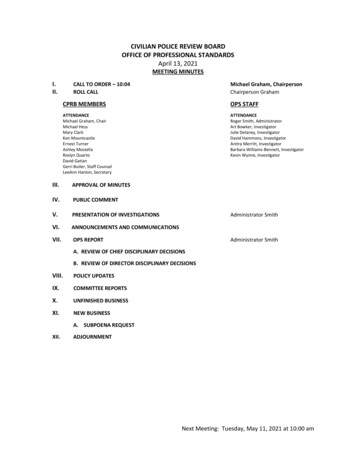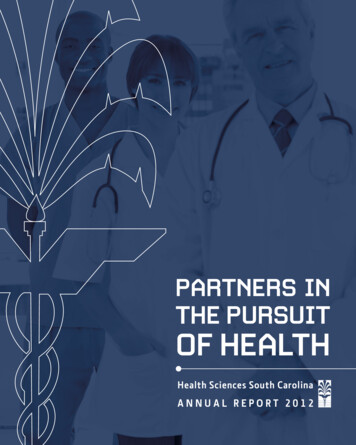
Transcription
PARTNERS INTHE PURSUITOF HEALTHHealth Sciences South CarolinaANNUAL REPORT 2012
ADVANCINGThe continuumof careLetter from the President and CEOLetter from the Chairman of the BoardcollaborationMembers and AffiliatesresearchMedical Research: The Clinical Data WarehouseMaking Life Better with the Coordination of Information:The Research Permissions Management SystemA History of Collaboration to Improve Healthcare: An Interviewwith Christine B. Turley, M.D., Chief Medical OfficertreatmentUnderstanding Telemedicine: Technology Is On CallDeveloping Research to Help Our Aging Population: The SmartStateCenter In Health Facilities Design and TestingwellnessCollaborating to Achieve the Triple Aim: Introducing the SCPartnership for HealthHealthcare Self-Management to Improve Outcomes: Health Studieshssc staff and newsHealth Sciences South Carolina Leadership and StaffGreenville Native to Lead the Duke EndowmentIn Memoriam1378101314171820
HSSC 2012 ANNUAL REPORT 1FROM THEPRESIDENT AND CEOWhat benefit is energy without direction;what can intelligence offer, withoutempathy? It is in concert that all great goalsare accomplished, and Health Sciences SouthCarolina (HSSC) is proud to look back uponthe past year and recount the achievementsmade possible through the teamwork ofour members, affiliates and communities.In our eighth year, our founding principal of collaborationhas yielded impressive results: Among them, a Clinical DataWarehouse (CDW), the Research Permissions ManagementSystem (RPMS) pilot program and statewide advances inhospital perioperative practices – each project proves thatpopulation health advances are possible when cooperationreplaces competition. This annual report features an in-depthview of these projects and other vital advances championedby our partners and affiliates. Our shared intelligence andpassion for better health have set South Carolina on the courseto become a state that does not merely react to the growingnational health conversation, but a state that stands at thevanguard of proactive, practical health innovations.HSSC is also proud to announce the appointment, after anextensive nationwide search, of the new Chief Medical Officerfor our organization, Christine B. Turley, M.D., formerly of theUniversity of Texas. Dr. Turley will provide clinical leadershipto HSSC, helping to ensure that HSSC remains an innovatorin the field of health research. Dr. Turley’s role includesserving as a catalyst for collaboration and the advancementof new healthcare initiatives with HSSC member hospitalsand universities.While each player and accomplishment is impressive, they gainincreased importance viewed in the context of our driving purpose:the “triple aim:” population health, cost reduction and patientexperience. The triple aim drives the development of each pieceof technology, motivates each study and is the target of ourcollective work to create improved population health, improvedpatient experience and reduced healthcare costs.We are all acutely aware of the changing face of Americanhealthcare. Our consistent pursuit of our strategic goals will besteadfast as we work for the good of South Carolina’s residents.Thank you for your commitment and partnership in that pursuit.Jay Moskowitz, Ph.D.President and CEO, Health Sciences South CarolinaFROM THECHAIRMAN OF THE BOARDIt has been my honor to serve the membersand affiliates of Health Sciences South Carolinaas Chair of the Board of Directors and to seethe progress made this year as we workedtogether in the spirit of collaboration to improvehealth for the people of South Carolina. Withcontinued support and passion from our boardof directors, affiliates and stakeholders, HSSChas been able to thrive this year–reachingmajor milestones and accomplishing positive results.HSSC has the unique position of convening the leading hospitalsystems and research universities of South Carolina to fostercollaboration and pursue value-added solutions. A primeexample of this teamwork is the Clinical Data Warehouse. At thebeginning of this initiative, HSSC members each brought theirindividual technical expertise to the table and joined together toleverage assets with the common goal of improving informationsharing and redefining medical research in South Carolina. Asa result, HSSC is on the cusp of launching this groundbreakingsystem, which will increase access to research and will ultimatelyinfluence positive health outcomes across the state.Other achievements that HSSC’s Board has contributed tothis year include implementing a new strategic plan for HSSC,focused on the needs of our supporting organizations andaffiliates as the nation’s health enterprise undergoes majorhealthcare transitions and economic demonstrations. Inaddition, we are proud to have Dr. Turley, HSSC’s new ChiefMedical Officer, on board working closely with HSSC’smember hospitals and universities to increase collaborationand advance new healthcare initiatives.I feel confident that with the ongoing collaboration andsupport of HSSC’s Board of Directors, affiliates andstakeholders, HSSC will continue to pursue the innovativeresearch needed to dramatically improve healthcare andthe health of all South Carolinians.Charles D. Beaman, Jr.CEO, Palmetto HealthChair, Health Sciences South Carolina Board of Directors
2 RUNNING HEADERCollaboratingto transformthe healthof south carolina
HSSC 2012 ANNUAL REPORT 3Health Sciences South Carolina:Good Health Made PossiblE Our members and affiliates work to transform the health of our state.Health Sciences South Carolina (HSSC) is a statewide biomedical research collaborative of three principal researchintense universities and four major teaching-hospital health systems: Clemson University, Greenville Hospital SystemUniversity Medical Center, the Medical University Hospital Authority, the Medical University of South Carolina(MUSC), Palmetto Health, Spartanburg Regional Healthcare System and the University of South Carolina (USC).The triple aim is the backbone behind our motto “Good Health Made Possible .” While the triple aim works toreduce costs, improve population health and improve patient experience, HSSC also focuses on collaboration,research, treatment and wellness. As we guide you through our successes of 2012, you’ll find that we’ve teamedwith our members and affiliates to produce better research, share results and collaborate to make South Carolinaa healthier place to live and work.PopulationHealthGood HealthMade PossiblePatientExperienceCostReduction
4 COLLABORATIONmembers & affiliates:A snapshotAnMed HealthMcLeod HealthAnMed Health experienced a major accomplishmentthis year being approved to become the first study sitein South Carolina for the ALERTS Pivotal US trial forthe AngelMed Guardian implantable cardiac monitorand alert system that is designed to reduce the time ittakes high-risk, heart-diseased patients to get to theemergency room during an impending heart attack.With this initiative, AnMed is working to shift theparadigm to prevention with early treatment at theonset of potentially life-threatening heart conditions.At the beginning of 2012, McLeod Health announcedits partnership with Loris Healthcare System in aneffort to collaborate and better serve the immediatecommunity. As a result, the newly named McLeodaffiliates, McLeod Loris and McLeod Seacoast, willbe able to better serve patients in the growing regionwith a network of physicians and specialists as wellas leading-edge medical technology. With a sharedphilosophy of quality patient care, McLeod Healthand Loris Healthcare System have had a successfulyear improving services and ensuring the deliveryof high-quality care for local communities.Clemson UniversityClemson University partners with Baptist EasleyHospital to put prevention first for patients (seepage 18), and leverages the power of the SmartStateCenter in Health Facilities Design and Testing toimprove hospital rooms, facility instrumentation andconditions in cardiac operating rooms (see page 14).Greenville Hospital SystemUniversity Medical CenterDuring 2012, Greenville Hospital System harnessed thepower of its Simulation Center, which uses simulationeducation to train health professionals and preparethem for interaction with real patients, to help shapethe curriculum of the newly opened University of SouthCarolina School of Medicine-Greenville. “The GreenvilleHealthcare Simulation Center allows these studentsto learn in an environment that’s safe,” said HurschellMatthews, Jr., MHA, EMT-P, Administrative Directorof the Greenville Healthcare Simulation Center. “Hereit’s okay for students who are trying something forthe first time to ask a question, to stop and get help.”The technology allows University of South CarolinaSchool of Medicine-Greenville students to embracea new school of thought–learning how to leveragetechnology in the rapidly changing world of healthcare.Medical University ofSouth CarolinaThanks to a federally-funded program involvingthe Medical University of South Carolina and selecthospitals in the Lowcountry and Pee Dee regions,hospital staff and patients in rural areas have access toexperts at large medical centers through telemedicine(see page 13).Palmetto HealthThrough its Office of Community Health, PalmettoHealth collaborates with community partners toprovide more than 20 health maintenance programsand direct healthcare services; one of the mostsuccessful is the provision of dental care. Withoutinsurance, many families rely on emergency roomsfor ailments large and small, including dental pain.ER dental visits incur up to 500 in additional costscompared to visits in a private dental practice. AfterSouth Carolina’s Medicaid program ended coveragefor all adult dental care in 2011, Palmetto Healthdeveloped an emergency oral health program in 2012to help uninsured patients avoid unwarranted ER visits.Palmetto Health’s Dental Initiative enlisted privatedentists to provide emergency dental services for fiveto ten uninsured, low-income patients per month.
HSSC 2012 ANNUAL REPORT 5Palmetto Health covers costs at the previous Medicaidrate. The program provides a benefit for all involved:patients gain access to otherwise unavailable services,dentists are reimbursed for their time and expertise,and the hospital avoids the higher costs of providingcare through its emergency rooms.Self Regional Healthcare SystemSelf Regional Healthcare System recently announced apartnership between its Healthcare Cancer Center andthe Hollings Cancer Center at the Medical Universityof South Carolina. Self Regional became the newestmember of the Hollings Clinical Trials Network. Thisnetwork is a statewide partnership of quality cancercenters dedicated to the promotion of cancer researchby establishing a collaborative infrastructure ofphysicians and clinical trials offices that can reach outto a large and diverse patient population by sharingresources with member organizations. The partnershipwill provide cancer patients in the seven-countyLakelands region that Self Regional serves accessto new and innovative cancer treatments, many ofwhich are not yet available to the general public.The Self Regional Healthcare Cancer Center openedin 2011 and offers advanced cancer care includingmedical, radiation and surgical oncology, and with thenew partnership Self Regional is able to advance itsmission of providing advanced care close to home.Spartanburg RegionalHealthcare SystemThe Gibbs Cancer Center at Spartanburg Regionalwas selected in 2012 to continue its participation inthe National Cancer Institute Community CancerCenters Program (NCCCP), a network of communitycancer centers focused on expanding research whileimproving access to quality care for underservedpopulations. The renewed funding awarded thecenter close to one million dollars to continueparticipating in the program for the next two years.Gibbs Cancer Center was one of the original pilotsites selected for the program in 2007. “If we aregoing to provide the most personalized care andstop the spread of cancer, we must work togetherto learn each other’s best practices while alsosharing our victories,” said James D. Bearden, M.D.,Vice President of Research for Spartanburg RegionalHealthcare System and Managing Physician of GibbsCancer Center. With a major focus on reducing cancerhealthcare disparities, the 21 NCCCP communityhospitals will continue efforts to enhance patientaccess to the latest, evidence-based cancer care,improve the overall quality of care and expandresearch opportunities across the cancer continuum.University of South CarolinaServing South Carolina is a priority at the University ofSouth Carolina. This year the USC Schools of Medicinehave placed a major emphasis on collaboration toachieve results. By spearheading the StatewideTelepsychiatry Initiative, USC works with hospitalsthroughout the state and the SC Department ofMental Health to help solve an increasing problem inSouth Carolina—mentally ill patients presenting atemergency departments not equipped to address theirunique needs. The telepsychiatry program is alreadyimproving patient care and reducing admissions, andhas demonstrated an average saving of 1,800 perpatient within 90 days.At the local level, the USC School of MedicineGreenville’s inaugural class is making an impact in thecommunity by undergoing required Emergency MedicalTechnician (EMT) training to gain certification and realworld experience in supporting the local community.
6 RUNNING HEADERAt the heart ofour missionis research
HSSC 2012 ANNUAL REPORT 7medical research: The ClinicalData WarehouseHealth Sciences South Carolina (HSSC) has been working for the past threeyears to establish a statewide Clinical Data Warehouse (CDW) system as partof its mission to improve the health of all South Carolinians.The creation of the CDW and a data management platformsupport the goal of significant growth in clinical trials andmedical research by collaborating across HSSC memberorganizations including:»»»»»»»»»AnMed HealthClemson UniversityGreenville Hospital System University Medical CenterMcLeod HealthMedical University of South CarolinaPalmetto HealthSelf Regional Healthcare SystemSpartanburg Regional Healthcare SystemUniversity of South CarolinaThe CDW solution consists of the following six components:12data sharing agreement is in place and governanceframework has been establishedmaster patient index (mpi) allows for the matchingof clinical records from across disparate informationsystems for a single patient3interface engine allows for the real time and/or batchinput and transformation of clinical data from the members’Electronic Health Record (EHR) systems and converts thedata into standardized formats4operational data store is a database designed to integratedata from multiple sources for additional operations onthe data. It is an important staging area for the data withinthe data warehouse architecture and provides the abilityto organize data across sources56data trust is the central database in the CDW architecturewhere aggregated data is stored and managedi2b2 (informatics for integrating biology and the bedside)is an open source application which allows researchersaccess to clinical dataCurrently, the CDW has data for 1.15 millionpatients from member institutions.
8 RESEARCHThe data being loaded currently includes demographics,diagnosis, procedures, labs and medications. Based oncurrent plans, Health Sciences South Carolina (HSSC)will have data loaded from present hospital members bythe end of 2014. Although the Clinical Data Warehouse(CDW) has been deployed for research purposes, thearchitecture supports secondary uses for the aggregatedor non-aggregated data including clinical data martsthat individual members could deploy for their uniquepurposes. Clinical data marts are an example of optionalservices that HSSC can provide, which leverage theinformation infrastructure. The architecture is designedto protect the security and the privacy of all patient data.Collaboration among the partner institutions willprovide the following value:» Honest broker services» Master Patient Identification (MPI) services» De-identification of data» Cohort selection for new trials and studies» Data to assist in obtaining new grants» Addition of new data fields» Addition of data from members’ other deliveryorganizations (i.e., physician practices, clinics, etc.)» Data cleansing and validation» Support for the development of optional dataservices (registries, clinical services and clinicaldata marts)making life betterwith the coordinationof information: TheResearch PermissionsManagement SystemThe Research Permissions Management System (RPMS) project wasundertaken in South Carolina with Grand Opportunity grant fundingfrom the National Library of Medicine.The RPMS collaboration included an Ethical, Legal andSocial Issues (ELSI) committee led by Duke University.Project execution followed a multidisciplinary approachand included team members with informatics, systemsengineering, software engineering, projectmanagement, ethics and regulatory expertise.Following the specific aims of the grant and institutedsoftware development practices, the team employedthe following iterative software development lifecyclethroughout the project:
HSSC 2012 ANNUAL REPORT 9analysisrequirements iningClemson University led the initial phase involvingsubstantial analysis focused on two key areas:1 systematic analysis of existing business practices,registration processes and consent collectionworkflows at each of the HSSC member healthcarefacilities and 2 investigative analysis of best practicesfor presenting information to users via tablettechnology and capturing permissions and consentdata electronically.The analysis of the existing hospital processes forobtaining, from the patient, permission to treatrevealed specific areas in which electronic formswould most effectively replace paper-based forms.This analysis influenced the design for the detailedworkflow embedded into the RPMS application.The general workflow included presentation of theinformation to a patient or participant, collection ofinformation from checkbox options and signatures,registrant review of the information and witnesssignatures. Institutional business requirementsincluded the ability to select appropriate formsapplicable for each patient or patient visit and theneed to accommodate multiple languages.Best practices for presenting and collectinginformation electronically were investigated usingparticipants at Palmetto Health. For example, the useof long forms with scrolling pages vs. the presentationof the information one page at a time with the use ofnavigation buttons. Also, the use of a tablet-baseddevice (Apple iPad ) vs. a fixed touch screen. Resultsshowed a preference by both registration clerks andpatients for a portable device (the iPad in this case).In addition, the paginated interface was preferredover the scrolling interface with less handling errors.These results influenced the design of the RPMS userinterface. The design was also informed by the resultsof a Video Assisted Consent (VAC) study conductedat the Medical University of South Carolina incollaboration with regulatory knowledge expertsusing a mock-up of RPMS code.A customized implementation of the RPMS softwarewas piloted in select patient registration clinics at MUSCstarting in November 2011. The implementation wasdesigned specifically for the statewide infrastructurethat is being established by HSSC. The stand-aloneRPMS software was extended to communicate withthe Enterprise Master Patient Index (EMPI) to optimizepatient lookups and to store collected data in theCDW. As a result, the final extended RPMS system wasinherently distributed with data transmitted from sourceregistration areas at the member institution to thecentralized HSSC CDW. For this pilot implementation,information from several paper-based forms typicallyused for consenting during patient registration wereconverted into electronic format and displayed on aniPad via the RPMS user interface.As of August 2012, over 2,300 patients wereregistered using the RPMS pilot at MUSC.In addition to permission to treat, the intention is toreplace the current, paper-based informed consentprocess used in clinical studies with an electronicsystem with minimal disruption to the researchworkflow. The introduction of this new medium tothe consenting process has several potential benefits.Patients are often presented with increasinglycomplicated informed consent forms during enrollmentin clinical studies. The forms are often verbose anddifficult to comprehend. The electronic format opensnew avenues for richer content in consent forms, suchas audio or video that can enhance the informationpresented and improve comprehension of the complexconcepts and/or procedures being researched. RPMSenables study coordinators to embed rich media intoconsent forms. The results of the VAC study suggestthat using videos to convey details about studyprocedures may increase participant understanding.Finally, consents collected electronically can bepresented back for patient or research participantreview via a patient research portal allowing themto review the list of research protocols and researchauthorizations to which they have consented. Theinformation presented in this manner empowers
10 RESEARCHpatients by allowing them tobe better informed, to makeinformed decisions aboutresearch and to provide accessto the research team.Thus, Health SciencesSouth Carolina (HSSC) hasdeveloped an electronicsystem designed tosimplify the collectionand management ofresearch authorizationsand informed consents.The captured data is fedto the Clinical Data Warehouse(CDW) with associated clinical data. The result is asystem that can facilitate the versioning and trackingof informed consents, enhance the consent processand facilitate research participant recruitment as wellas the coordination and management of a statewideclinical trials network. Future plans include thedevelopment of best practices for the presentationof multimedia in consents; the incorporation ofInstitutional Review Board (IRB) workflow; a detailedanalysis of the impact of RPMS on the consent processand research recruitment; and the addition of othercomponents to RPMS such as a patient portal toempower patients and research participants about theirdecisions on consents and authorizations that accrueduring their interactions with the research enterprise.The final version of RPMS, which offers new featuressuch as the support for the workflow of the informedconsent to participate in research and consent formdesign tools, has been completed and released underan open source license at www.healthsciencessc.org/rpms. The platform is extensible and configurablewith the ability to be used in multiple consentingenvironments such as patient registration for routinecare or informed consenting for clinical trials.CHIEF MeDICAL OFFICERA history of collaborationto improve healthcare:Christine B. Turley, M.D.Q:How does your position with HSSC leverage yourexperience in the field of health? I have practicedmedicine in varied settings during my career. I havecared for patients in public health settings, in ruralsettings where I was the only pediatrician servinga large part of a state and in one of the poorestpractice types in the United States, an academicpediatric training location. I have also held a numberof leadership roles in academic healthcare which hasgiven me personal knowledge of the increasingpressure on healthcare to make meaningfulimprovements. Finally, my clinical research programcentered on vaccines, and I had the opportunity todevelop knowledge and expertise regarding all aspectsof clinical research in all populations and at all stages ofvaccine development. I believe that my diverse areas ofexpertise all come together in my role at HSSC. I drawupon my knowledge of the practical realities of practicingmedicine, as well as my personal understanding of thebusiness and financial issues confronting health systems.I also have the opportunity to use my experience in boththe human subject components of clinical research and
HSSC 2012 ANNUAL REPORT 11the complexities of the regulatory aspects of clinicalresearch. The ability to consider a research questionalongside a pressing clinical need is a strength that Ipossess, and my role at HSSC affords me the uniqueopportunity to combine this knowledge to improvethe health of all South Carolinians.Q:Since you have joined the HSSC team towardthe end of 2012, what are some of the goals thatyou are looking toward with the organization in thenext few years? We have a three-pronged primaryagenda. First, we will be focused on maximizingthe use of our data warehouse. This unique datarepository is a valuable asset for members and thestate that aids in development of new knowledgeand health system improvement. We are developingstrategies to expand our membership to incorporateeven more comprehensive data, leveraging our uniquecollaboration for the most benefit.Our next goal will be to develop our data platform tobe a highly functioning tool in the rapidly changingarea of personalized medicine. We will work closelywith our members to pull the technical data that existsin various repositories around the state into our centraldata warehouse to create a powerful tool that affordsresearchers improved understanding of the complexinterplay of genetics and environment. This willbecome a means for physicians to deliver medical careto patients that is most meaningful to their specificrisks and strengths.Our third area is developing clinical research projects tomake use of the talents of the faculty at our memberinstitutions to maximize the potential of the currentdata warehouse to improve the health status of SouthCarolinians. We would like to make optimal use of thetools that HSSC has been developing to advance theknowledge and understanding of health and healthcarehere in South Carolina, as a model for the country.Q:Are there particular healthcare initiatives thatyou have identified to implement in SC? We aredeveloping two areas of research to begin in the nearfuture. We are working with members and partnersto understand factors associated with readmission.We will be working to reengineer the transitions incare to improve outcomes for patients during thisvulnerable period. We are also interested in decreasinghealth disparities with a novel demonstration projectinvolving prevention of hypertension.Q:How do you propose increasing collaborationamong SC’s hospitals and universities? My first task isto work with our member organizations to develop avision that is consistent with their interests and goalsover the coming years. My initial efforts are beingspent in listening and reflective dialogue with leadersat our organizations across much of the state. Eachhealthcare organization is focused on excellence andimproving patient care.Establishing a dialogue about these topics will aidin developing the common platforms for workingtogether. Each entity is committed to improvingthe health of all South Carolinians, and that is afundamental unifying aim.With the history of collaboration among HSSCmembers as a foundation for the future, there istremendous groundwork for working together ineven more meaningful, collaborative ways.Q:In addition to your work with HSSC, you willalso serve as professor of clinical pediatrics in theDepartment of Pediatrics at the University of SouthCarolina School of Medicine-Columbia and serve asOffice of the Dean advisor for USC School of MedicineColumbia Clinical Affairs. What are you lookingforward to with these positions and how will yourwork in those capacities complement your work withHSSC? My activities at the School of Medicine (SOM)are complementary to my role with HSSC. Specifically,I am looking at ways to bring faculty from the SOMinto research opportunities developing within HSSC.I have begun to work with department chairs to aid inthis venture. Additionally, I will be advancing researchactivities in ways that dovetail with the initiativeswe are working on across the state. My work in thepediatric department will focus on patient care andeducation of pediatric residents in the clinical setting,which allows me to combine these two professionalareas. Continuing clinical practice is essential to helpingme stay in touch with the realities of the changingenvironment of medicine. Working with learners is animportant connection to a critical mission of academichealth centers, educating the next generation ofphysicians. And finally, these two areas are just fun!
12 RUNNING HEADERPracticalresults forpracticingmedicine
HSSC 2012 ANNUAL REPORT 13Understanding Telemedicine:Technology is on callFaculty at both the University of South Carolina and the Medical Universityof South Carolina (MUSC) are working to transform access to specialists andreduce health disparities through the use of telemedicine. Rural communitiesthroughout South Carolina and the United States can present special challengesfor patient care, often centered around limitations in access to specializedcare in Emergency Department settings. This can lead to significant healthdisparities which contribute to poor outcomes.A federally funded program involving the Medical University ofSouth Carolina and select hospitals in the Lowcountry and PeeDee Regions was established under the acronym CREST (CriticalCare Excellence in Sepsis and Trauma) by Dee Ford, M.D. andSamir Fakhry, M.D.Using telemedicine, MUSC staff and staff members fromparticipating hospitals have an audiovisual connection,enabling them to see and hear each other, as well as thepatient, resulting in a more thorough evaluation anddocumentation. “Roughly half of the 40,000 annual trafficfatalities occur at the scene,” says Dr. Fakhry,
vanguard of proactive, practical health innovations. HSSC is also proud to announce the appointment, after an extensive nationwide search, of the new Chief Medical Officer for our organization, Christine B. Turley, M.D., formerly of the University of Texas. Dr. Turley will provide clinical leadership to HSSC, helping to ensure that HSSC remains an innovator in the field of health research. Dr .






